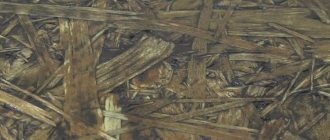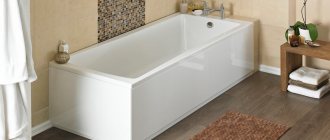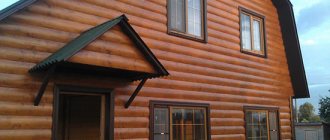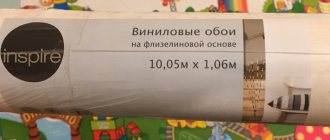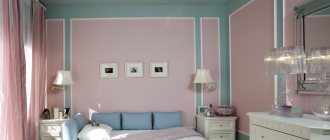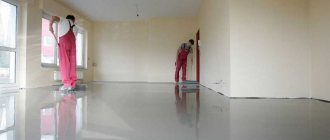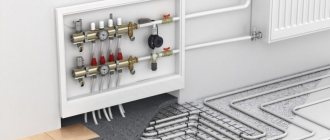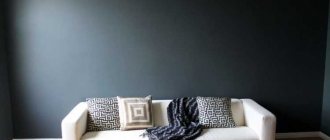Home » Building a house » Building materials
Annie Cooper 04/30/2020
34037 Views 1 comment
Oriented strand boards are often used for exterior decoration of building facades and interior work. Their characteristic, rough structure does not always correspond to the style of the room or the wishes of the home owner, so the surface is covered with paints and varnishes. Tips on what and how to paint OSB, and how to properly prepare the material for coating are collected in the material.
Material characteristics
Surface of particle boards
OSB (OSB) or oriented strand board is a sheet building material made from woodworking products (most often flat softwood chips) glued together in 3-4 layers.
The material is formed by hot pressing. The binding element is waterproof phenol-formaldehyde resin with the addition of synthetic wax and boric acid.
The name OSB is a transliteration of the English name OSB - oriented strand board.
The entire slab has a thickness of up to 3.8 cm and a length of up to 2.5 m. For production, chips of a strictly defined size are used: from 0.6 to 4 cm in width and 18 cm in length. The order of the layers in the sheet also matters: the inner ones are laid transversely, and the outer ones - lengthwise.
This structure gives the material the properties of a plywood sheet:
- increases rigidity
- prevents deformation during installation
- increases resistance to mechanical damage
Application of OSB panels
OSB is used as rough flooring (under laminate, carpet, linoleum) or wall material for construction:
- temporary structures
- frames
- small architectural forms
- converting an attic into a living room
The material is also used as a raw material for the production of sandwich panels, I-beams, as a flooring for bitumen shingles on roofs and load-bearing structures of panel formwork.
OSB competes with bakelite and regular plywood as a structural material, and fiberboard, chipboard and plasterboard as a finishing material.
Types of OSB
OSB boards can be divided according to different criteria. This is the level of moisture resistance and strength, the presence of locking joints, the environmental friendliness of the material, and the thickness of the sheets.
There are several types of OSB. And not all of them are equally suitable for interior decoration.
According to their physical and technical characteristics, oriented strand boards are divided into four types. Each of them has its own purpose. Therefore, when purchasing building materials, it is necessary to take into account the conditions under which they will be used.
- OSB-1 does not have high strength and moisture resistance. Therefore, they are usually used as auxiliary material. Their cost is low, and they are often used, for example, to create temporary formwork. After dismantling it, it will not be a shame to dispose of the used parts.
- OSB-2 - characterized by fairly high strength, but not outstanding moisture resistance. As a construction material, they can only be used for interior work and exclusively in dry rooms. Suitable, for example, for covering light partitions in a room.
- OSB-3 are products that can be called universal. The boards are used both in dry rooms and in conditions of high humidity, including outdoors. They cover walls, form interfloor ceilings, and lay rough and “clean” floors for decorative coverings. They are often used as a material for continuous sheathing under some types of roofing coverings.
- OSB-4 - products with high moisture resistance and excellent strength. Therefore, they can be used in various fields of construction, including to create self-supporting loaded structures.
The slabs are most often produced in sizes 1250×2500 or 1220×2440 mm. Thickness range – from 6 to 25 mm. There may be other dimensions in length and width - this is worth paying attention to. Sometimes non-standard sizes allow you to choose the best option for a specific coverage area. That is, they make it possible to avoid a large amount of waste when cutting material.
OSB boards can be regular or tongue-and-groove.
Oriented strand boards are often produced with straight ends. But for finishing work, you can also look for tongue and groove ones.
- Conventional OSB sheets have smooth edges. When covering surfaces at joints with them, it is necessary to maintain a technological gap of 3–5 mm, which will keep the coating intact during thermal expansion of the material. Such slabs must be rigidly fixed to the base using self-tapping screws screwed in at intervals of 350÷400 mm. It is recommended to fasten large OSB sheets not only along the perimeter, but also additionally along the diagonals.
Tongue-and-groove OSB boards allow for a virtually seamless covering.
- Tongue-and-groove slabs are equipped with a tongue-and-groove joint. This option is more convenient when the slabs are planned to be used as a finishing coating, including for further painting. The joints are more accurate, and the gaps between the plates are practically invisible. When attaching tongue-and-groove OSB boards to a flat base, you do not have to use many screws. In addition, the products can be used for floating coating when installed on a concrete base.
Another important criterion for choosing OSB boards is the materials used in their manufacture. This parameter is especially important if the slabs are purchased for covering surfaces inside residential premises.
Formaldehyde resins can be used as a binder for wood chips, which release toxic fumes into the environment. Such materials have a formaldehyde emission class of E2 and higher, and are not suitable for internal use.
OSB boards produced according to European standards and marked “ECO” or “GREEN” are suitable for this application. The production technology excludes the presence of toxic compounds in the material. Wood raw materials are pre-treated with paraffin-wax impregnations, and polyurethane resins are used as a binder, which after polymerization become completely harmless to the environment.
The level of formaldehyde emission is indicated by the assigned class. E1 can be considered acceptable for residential premises, but E0.5 is better. And the best option is the already mentioned above “ECO” sign.
This option is fully suitable for residential premises. And it can be safely used for painting.
The certificate of conformity must indicate the formaldehyde emission class. For interior work, it should be no higher than 1, but better than E0.5 or “ECO”.
But in order to guarantee the “purity” of the material, when choosing it, you must carefully study the markings on the sheets. And this information must be confirmed by a certificate of quality (conformity), presented by the seller at the buyer’s request.
Advantages and disadvantages
Pressed chip sheets
Oriented strand boards are superior to other building materials made from wood products in some performance characteristics:
PROS:
- Show higher fire resistance than fiberboard, chipboard, non-flammability
- They do not have defects in the material structure (delaminations, air voids, knots) unlike solid wood
- Less time-consuming compared to other types of finishing
- Provide high heat and sound insulation
- Cost less than other wood chip materials
- Externally they differ little from wood
- Not affected by wood-boring insects
- Easy to process (drill, cut, glue and paint)
- Lighter than cement bonded particle boards/
MINUSES:
- However, OSB does not provide vapor permeability.
- When heated, it can release harmful substances (due to the phenolic-formaldehyde resin in the composition).
- When used in interior decoration, sheets must be painted or covered with other decorative material.
Paint application technology and drying
Once the primer has completely dried, you can begin painting.
In order to ensure the quality of the finishing coat, it is best to do a test paint job. This will allow you to make the necessary adjustments regarding the technology for applying the protective layer and the thickness of the paint.
OSB can be painted with a brush, roller or spray. Of course, the latter method is most preferable if there is a large amount of work to be done. In addition, automatic spraying will provide an even layer of paint and reduce its consumption.
Applying the first coat of paint
It is convenient to treat hard-to-reach places, ends and edges of sheets with a paint brush. When working with this tool, strokes should be carried out in one direction, distributing the paint until a thin, uniform film is obtained on the surface. The same recommendations apply to applying the composition with a paint roller.
After completing the base layer, take a break long enough for it to dry. Then re-staining is carried out.
For final painting of OSB, you can choose the color to your taste
Drying of the topcoat should take place at a constant temperature recommended by the paint manufacturer. In addition, there should be no drafts in the room, and the air humidity should be no more than 60%.
At this point the staining process can be considered complete. As you can see, painting OSB walls or floors is not difficult if you properly prepare the surface of the slabs and choose the right materials for the job.
Types of slabs
Laminated Chip Board
There are 4 types of slabs depending on their resistance to moisture and mechanical stress.
| View | Characteristic | Application area |
| OSB-1 | Low resistance to moisture, shock, deformation | Manufacturing of furniture, used as packaging material, upholstery |
| OSB-2 | High strength but unable to withstand moisture | For the manufacture of load-bearing structures, floors, only in dry rooms |
| OSB-3 | High resistance to damage and moisture | For the production of load-bearing beams and structures in any premises |
| OSB-4 | The highest levels of moisture resistance and strength | Can be used for any premises and purposes |
For finishing, the preferred choice is oriented strand sheets of types 2 and 3.
Depending on the outer covering, sheet material can be:
- Varnished
- Laminated
- tongue and groove
The elements are distinguished according to the finishing method:
- with straight edges
- milled (to simplify installation) on both sides
- milled on four sides
A little introduction
Even before I started working with these boards, I learned from my friend that OSB is a composite element that is created by gluing wood chips. Polymers and various resins are used for these purposes.
How to paint OSB indoors
There is also a classification of this material, which you should not forget about when purchasing OSB boards:
- OSB 1 - suitable for interior design of rooms where there is a low level of humidity
- OSB 2 – for rooms with normal humidity
- OSB 3 – for high humidity levels and floors that can get wet
- OSB 4 – are the most moisture resistant, they are used for load-bearing structures
For my room I used OSB 3 - together with OSB 2 they are best suited for interior decoration. Deciding to play it safe once again, I chose this particular class, but if you are confident in the humidity of the room, then you can use the second class, it is usually a little cheaper in cost.
Manufacturers and prices
Finishing building materials
The most widely used chipboards on the market are those produced in Germany, Romania, Canada and Russia. The main brands with prices per 1 sheet are presented in the table:
| Brand name | Manufacturer country | Price for 1 sheet |
| Glunz | Germany | from 1200 rub. |
| Arbek | Canada | from 800 rub. |
| Norbord | Canada | from 1000 rub. |
| Egger | Romania | from 1000 rub. |
| Talion | Russia | from 500 rub. |
| Kronospan | Austria | from 550 rub. |
| Kalevala | Russia | from 600 rub. |
German sheets from Glünz are considered the highest quality (but also the most expensive); Canadian products have proven themselves well: Arbeck and Norbord. Among Russian-made building materials, OSB brands Kalevala and Talion are popular.
Selection of OSB panels depending on the final cladding
Even at the stage of purchasing OSB panels for repairing the ceiling surface, you need to decide on the method of its final finishing. After all, incorrectly sheathed ceilings are much more difficult to veneer. There are a few things to consider here.
- The use of tongue and groove slabs will create a monolithic surface without joints, which will greatly simplify the final painting or application of varnish.
- Before varnishing and painting, the fastening screws should be recessed flush with the surface. This is achieved by countersinking the holes for them with a drill of a larger diameter.
- An alternative final finishing option is to cover the ceilings with laminated OSB sheets, then subsequent decoration will not be required at all.
- When constructing rough ceilings from OSB, panels with a thickness of 12-17 mm or more should be used. After all, they will have to be a support for suspended structures.
More information about the types of OSB sheets can be found in the article: OSB - description, types, characteristics.
Preparing for painting
Painting sheets of shavings
Before you begin to apply the coloring product to the material indoors, it is prepared. The adhesion of the paint and the durability of the structure depend on the quality of the preparation.
Prepare the already assembled elements in the following sequence:
- Sanding with sandpaper or a sanding machine to eliminate unevenness and mask the recognizable texture of OSB. OSB-3 and OSB-4 sheets are especially carefully sanded, where the wax (varnish) protective coating must be removed. By skipping this step, there is a risk of chips and large chips peeling off
- Blowing wood dust from seams after sanding
- Leveling in places of fastening with self-tapping screws using putty mixtures based on glue and oil, “liquid nails”
- Cleaning dried putty with fine sandpaper to obtain a smooth surface
- Treatment with specialized emulsions that give the material additional resistance to moisture, combustion, fungi, and mold
- Primer with a mixture of alkyd varnish with water or white spirit (in a ratio of 1 to 10). An adhesive primer is also suitable, which will not allow the essential oils in the structure of the slab to bleed through the light pigment. If OSB-3 and OSB-4 are primed, then choose compositions for applying decorative plaster or mosaic
- The perimeter of each element is painted with a brush in 3 layers, the internal space is worked with a roller in 1 layer in one direction.
- Allow the paint to dry completely and apply a second coat.
If the material is coated with water-dispersion compounds, then only 1 layer is placed over the entire surface of the slab - this way the slab will swell evenly.
Staining
Another way to design OSB is to treat it with stain. This is a composition that gives wood a tint, but does not create a film on its surface.
Treatment of OS boards with stain:
- Sand the surface with sandpaper, drill or grinder with a special wheel.
- Remove dust.
- If there are cracks, fill them with putty and sand them again.
- Apply the composition in 3 layers. The first and last along, the second across.
- After the last layer has dried, sand the surface of the slabs again with sandpaper or a wheel with the finest grain.
- Remove sanding dust.
Stains, like impregnations, protect the painted surface from rotting, moisture, and impart fire-retardant properties. The coating can be transparent, translucent, or completely opaque. There are stain varnishes on sale that combine the properties of both types of paints and varnishes. They simultaneously protect the surface, give a beautiful shade and create a glossy film.
How to choose a coloring composition
Choosing paint for wood board
To choose a paint for coating sheet particle material, it is recommended to pay attention to the following properties:
- protection from ultraviolet radiation, negative effects of the atmosphere (rain, snow accumulation), fire, rot, mold
- the presence of additives with fire-retardant and adhesion-increasing characteristics
- surface adhesion parameters
- number of layers (to calculate consumption per 1 m2)
It is also worth considering the age of the boards (the older the OSB, the worse it adheres to the surface) and their condition (before painting, the surface is cleaned of dirt, layers of old paint, and treated with antiseptics).
Preparatory work
Before you begin work, you should know what preparation should be for painting and finishing OSB boards. Its quality determines the further consumption of the paint and varnish and its appearance.
- The sheets are polished to remove manufacturing defects.
- Fill cracks with sealant.
- Level the surface with putty (it is recommended to use an acrylic composition for this purpose).
- Sand the dried layer with fine-grained sandpaper.
- Apply primer.
Before painting OSB indoors, you should pay attention to the commercially available primer options. They come in three types:
- acrylic;
- alkyd;
- adhesive.
Acrylic primer is odorless. This primer is easy to apply and wash off from tools. The line of acrylic compositions includes antiseptic mixtures that prevent the appearance of fungus and mold. They are suitable for processing OSB sheets inside the house and for work related to wallpapering.
Alkyd primer. It is used only in conjunction with alkyd paints. This type of primer is universal: it is good for both interior work and when processing facade panels. The only drawback is the strong smell.
Adhesive primer. This composition is almost never used when painting OSB boards inside a building due to the quartz filler included in the base of the primer mixture. After using adhesive agents of this type, additional sanding of the surface is required.
Indoor painting methods
Particle boards in interior decoration
OSB is coated with paints and varnishes to:
- Additionally protect the material from moisture and reduce the risk of fire
- Disguise the texture of slabs during interior decoration and add decorativeness to them
- Save on cladding with plasterboard or MDF panels
Experts do not recommend covering building materials with water-dispersed acrylic compounds in several layers for exterior work - the slab may swell.
OSB wall panels
For interior work, particle boards cover:
- Oil paint - it has high viscosity and is not absorbed into the material. Provides a reliable, durable coating, but takes quite a long time to dry
- Alkyd paint or enamel. Penetrates deeply into the structure of the chips, so there is no need to varnish the material on top
- Stain. With this type of painting, the natural texture of the slab remains visible. The top of the building material is coated with polyurethane or vinyl varnish to secure it. The desired tone can be obtained by diluting the composition with water, acetone or solvent
- Glazing azure. Transparent thin paint allows the chips to retain their structure and only slightly shades the color
- Transparent varnish or impregnation to preserve the natural texture of the slabs
Features of the material influencing the choice of paint
OSB boards can be called a specific material due to the pronounced texture of individual chips on the surface and some other features.
Before you start choosing a particular type of paint, consider the following points:
- Without preliminary surface treatment, the paint may adhere poorly or unevenly to the base. This occurs due to poor adhesion or because the slabs are treated with special impregnations, which in turn form a film on the surface;
- It is not recommended to choose water-based compositions due to the fact that excess moisture can lead to swelling of the surface;
- A rough surface will require more paint;
- If the slabs are poorly painted even after careful preparation, it means they were stored incorrectly. Material that has been lying outside for more than one year must be thoroughly cleaned of dust and other contaminants, sanded and treated with antiseptics;
- At the ends, the slabs have a more porous structure; accordingly, they will require more paint to fill the voids. To avoid excessive consumption, it is recommended to pre-treat the seams.
How to paint the panels outside
Painting slabs outside
For external finishing work - finishing the facade, installing partitions and floors - oriented strand boards are coated with impregnations, varnishes and paints:
- alkyd
- oil
- water-based
- acrylic
- latex
When choosing a material for painting, it is better to choose compositions that contain special additives that protect the slabs from exposure to UV radiation.
The coating must also be vapor permeable, otherwise mold will form on the slabs. An impermeable coating can cause warping of sheet building materials.
Alkyd paint
Alkyd paint
Alkyd paint Its composition includes plant resins, film formers (glyphthalic or pentaphthalic), pigments, purified kerosene, fillers and antiseptics. After coating and drying, a film remains on the surface of the material, which provides additional strength to the OSB.
Dries quickly, is non-toxic, creates a waterproof layer, protects against temperature changes. However, it has a pungent odor and is prone to fire.
If such a composition is applied to the slab before it dries completely, bubbles and peeling will form on the surface. This coating significantly reduces finishing costs, because the alkyd composition eliminates finishing impregnation with varnish.
Water-based mixture
Water-based paint
Water-based mixture The composition of the two-phase mixture includes water and acrylic, fillers, film formers, pigments and a number of functional additives. After drying, the water evaporates, and the polymer layer gives the slab improved performance characteristics.
In addition to such advantages of paint as quick drying, non-toxicity and lack of a strong odor, the advantages include:
- low price
- variety of colors
- high resistance to fire and moisture
- ease of application
- service life up to 10 years and above
External work is carried out at a temperature not lower than +5. In the cold the composition becomes unusable.
For finishing, water-dispersion relief paint with the addition of marble dust or fine chips is also used. Its cost is higher than that of traditional water-based paint, but due to the relief it produces a beautiful decorative look.
Latex composition
Latex composition
Latex composition A type of water-based paint, but instead of acrylic, the binder is a latex additive (based on vinyl, polyvinyl, silicone). The composition is elastic, viscous and durable, giving the surface characteristics of resistance to moisture, aggressive chemicals, UV radiation and temperature changes.
The paint is non-toxic and has no unpleasant odor. Using latex, you can get both a smooth and textured coating.
Acrylic based coating
Acrylic copolymer paints
Acrylic-based coating This raw material covers unevenness of the structure well and gives a uniform tone. It consists of polymers, water and dye, and after drying it leaves a durable film on the surface of the material. It can be matte or glossy; there are many colors in the assortment that do not require additional tinting.
The acrylic composition does not spread, does not fade, dries quickly, has the ability to allow steam to pass through, but is resistant to moisture. It is often used for interior work because it is non-toxic and does not emit harmful substances into the atmosphere when heated.
Oil paint
Oil paints
Oil paint Raw materials using drying oil are rarely used due to their high toxicity and long drying time.
The oil composition leaves a lot of streaks and unevenness, while the coating does not last long, quickly crumbling and peeling off from the surface.
How to paint OSB
Preparatory work
Before painting, the slabs must be prepared. This is necessary so that the paint adheres well and sticks to the surface.
If you plan to cover the walls and ceiling with strand boards, then it is easier to carry out the preparatory work even before installing the boards on the sheathing.
Depending on the chosen painting technique, it may be more profitable to do it in advance, before installing the sheathing. This is due to the fact that some of the decorating methods involve several stages of cleaning and painting.
- So, the first step is to clean the entire surface using a hand-held sanding machine, onto which a sandpaper attachment is attached.
Cleaning the OSB surface from the protective layer.
If you plan to preserve the textured pattern of the OSB, then an sanding attachment with a medium-sized grain (approximately P120) is selected for sanding to free the surface from the protective layer of binders. If the slab needs to be leveled to smoothness for continuous painting, then the cleaning is carried out first with coarse grains (P80), and then with fine grains (P200 and higher).
After removing the top protective layer, the primer or paint will easily penetrate into the structure of the material.
If OSB-3 or OSB-4 boards are purchased, then their cleaning should be carried out most carefully, since they have a more reliable varnish coating on the surface.
The screw caps must be recessed into the wood by 1÷2 mm. The seams between the laid sheets are puttied.
- The second step in preparing the slabs is to mask the seams and screw heads. Various means are used. This, for example? It can be ready-made parquet on an oil-adhesive basis or a special elastic putty. A sealant or special elastic tape is used.
Elastic putty for joints between OSB boards.
If the joints and holes from the screws need to be completely hidden, preserving the natural color or making it several tones darker, then sawdust should be added to the putty, which will remain when cutting the sheets. In this case, the gaps must be filled very carefully, without going beyond them. And if necessary, after the putty mass has hardened, the seams are cleaned with a grinding machine with an emery attachment.
Durable and airtight “RAPID CELL” tape for sealing seams between OSB boards.
If the surface should be smooth and uniformly colored, then elastic tape is used to mask the seams.
- The next step is to apply a primer to the slabs under a solid monochromatic painting, which can be polyurethane-acrylic, acrylic or alkyd varnish. The choice of composition depends on the paint base that will cover the surface. When using water-based varnish as a primer, it must be diluted in a ratio of 1:10 with water.
Priming the surface with diluted varnish
When choosing an alkyd varnish, “White spirit” is used as a thinner.
Besides these options? For preparatory work, adhesive primers are used, for example “Aqua Filler”. This type of primer is designed to isolate wood from paintwork. Such compositions are especially suitable for coating slabs made from coniferous wood, since the primer will prevent the resin from bleeding onto their surface.
The sequence of preparatory work for decorative painting using primer paint.
In addition to the primers listed above, a special primer-paint can also be used to pre-prepare OSB for painting.
OSB painting
So, OSB boards can be painted in one color, maintaining the texture or leveling the surface to smoothness. This type of painting is not difficult to do - it is not particularly different from the usual application of paint on any other base.
When painting large areas, it is most convenient to use a paint roller
The painting process will go quickly if you prepare the slabs correctly. However, there are other techniques that can change the slabs beyond recognition, reliably hiding the joints and fasteners.
Agree, the painted surface does not look very presentable
This is what the slab will look like if you simply apply paint to it with a roller or brush. This option is unlikely to be suitable for residential premises. Therefore, some home craftsmen and professional finishers are developing and putting into practice more creative options for painting OSB boards.
There are several available options available.
The first option for decorating OSB
In this case, the floors are finished using multi-layer painting technology. Achieving this effect will require a lot of time and patience.
To paint the floor, you need to prepare several tones of the same color. The work occurs in the following order.
Option for painting OSB floors - imitation stone surface
- The first thing we recommend doing is drawing up a sketch of the future floor design. Moreover, it is advisable to execute it in two versions - graphic and color. The sketch will clearly show what the finished coating will look like and will also help in further work.
- The slab is completely painted with primer paint of the base color. The lightest shade of the selected color should serve as the base. To apply paint you must use a spray gun. This application will ensure that the paint gets into all the recesses of the textured surface, while maintaining the surface relief.
- To emphasize the depth of the relief, the floors can be lightly sanded with a sander.
- Now the entire painted surface is divided into fragments shaped like stones or other elements. The marking is carried out based on the drawn up sketch, first with a simple pencil. And then it is “raised” with a brush and paint 4-5 tones darker than the base color.
- The next step is to paint each fragment of the coating with paint of a different tone, which must be prepared in advance.
- Next, each of the fragments is cleaned. At this stage, it is not necessary to process the entire surface; you can clean one or two sides of the stone, simulating its volume.
- Then the contours of each of the stones are drawn again.
- After drying, the surface is coated with varnish, the base of which is selected depending on the type of paint.
This coloring option is only available to a creative person who knows how to work with paints.
Second option for decorating OSB
If you don’t want to come up with the shape and size of the stones, you can go another way. Specifically, lay out a covering of small square slabs. Adjacent panels are laid so that the direction of the laid chips is perpendicular to each other.
Mosaic laying of square slabs in a checkerboard pattern will somewhat “revive” the floor surface
This option will allow you to create an original textured pattern of the floor covering and well disguise the joints between the slabs.
If the OSB has a color that satisfies the home owner, then the coating can simply be coated in several layers with varnish or epoxy, having previously cleaned the surface. If the shade is not completely satisfactory, it can be changed using stain or the technique suggested below.
However, it must be taken into account that the slabs will have to be cut into separate fragments, the edges of which must be perfectly smooth. In addition, this type of flooring will look aesthetically pleasing only on a perfectly flat base.
The third option for decorative painting of OSB
This method of painting slabs is accessible to anyone, even an inexperienced craftsman. The main thing in this process is to follow the instructions provided by the professionals.
Some try to achieve this or a similar effect on the walls using decorative plasters. But it turns out that a surface made of OSB sheets, paint and a little effort is quite enough.
The photo shows an example of painting OSB, which is used to cover the walls inside the house. In this case, two colors of paint were used for decoration. But if desired, more of them can be used, depending on the desired result.
How the process of decorating OSB is carried out using this technique will be presented using the example of small sections of slab in the instruction table.
To work in this case, the tools used were a Kremlin HTI spray gun with a 1.8 mm nozzle, a sanding machine with sanding attachments having grains of different sizes, and a special sponge with an abrasive surface.
| Illustration | Brief description of the operation performed |
| So, the first step is sanding the surface. A grinding machine with an emery attachment with P180 grain installed on it is used. The process is carried out without strong pressure, since only the protective layer needs to be removed from the stove. | |
| Since paraffin or wax, as well as resins, are used in the manufacture of OSB, the surface of the board must be coated with a barrier primer. It will delay the penetration of resins and paraffin on the decorated floor covering. In this case, barrier soil FI M 194 is used. Soil consumption will be 50÷60 grams per 1 m². The primer is applied using a spray gun. The drying time for this layer is one and a half hours. | |
| The next step is to apply a pigment primer to the entire surface of the slabs, which will become the basis for creating the color scheme of the finishing material. In this case, white polyurethane primer is used. The consumption of pigment primer will be 90÷100 grams per 1 m². The time required for the coating to dry under normal conditions is 3÷4 hours. | |
| When the soil is completely dry, the part must be sanded again using sandpaper with a grain size of P320 on the sanding machine. After sanding, the surface must be thoroughly cleaned of dust using a vacuum cleaner. | |
| To create the effect of a delicate shine, the next step is to apply the “Mother of Pearl Effect” composition to the surface. The consumption of the wet applied layer will be 100÷120 grams per 1 m². And then 40÷60 minutes are given for the composition to dry. | |
| Patina paint is sprayed on top of the mother-of-pearl layer, also using a spray gun, which will give the effect of “noble aging.” The consumption of this composition is 60-80 grams per 1 m². | |
| 5-7 minutes after spraying the patina, its excess must be removed with an emery sponge (block) with P320 grain. Then the entire surface must be thoroughly cleaned of dust with a vacuum cleaner. | |
| This photo shows the result of the work done. He is already quite capable of becoming the final option. But if you wish, you can continue decorating. | |
| The next step is to spray tinted acrylic varnish mixed with stain over the slab. Instead of stain, another painting composition can be used. The main thing is to take into account that the composition of all the solutions used for coloring were organically combined with each other. In this case, a zero-gloss varnish was used. Its consumption will be 80÷100 grams per 1 m². This layer should dry for one and a half hours. | |
| As the varnish coat dries, the color may change slightly, and its dullness will increase. This factor must be taken into account when composing the shade of stain or paint. | |
| The finishing coating can be matte, glossy or soft touch. “Soft-touch” literally translates as “soft to the touch.” This is a special rubber-like elastic matte paint coating. This option is perfect for wall surfaces. |
When choosing this coloring technique, great opportunities for creativity open up. It’s quite possible to come up with your own options that will please the eye.
* * * * * * *
As can be seen in the examples shown, in any case, the specific surface structure of oriented strand boards can be “played up” for the benefit of the overall decorative effect of the coating. That is, painting OSB may well be considered a full-fledged finishing technology.
At the end of the publication, there is a video that demonstrates another easy-to-do-it-yourself method of original painting of an OSB surface.
Fire protection
Soppka paint and varnish material
In addition to making the slabs decorative, painting can also be aimed at improving the performance characteristics of OSB. When ignited, particle boards emit caustic phenolic smoke, which is dangerous to humans, so it is important to cover the material with fire-retardant solutions.
Soppka paint is produced specifically to increase the resistance of particle boards to fire. The composition also prevents the development of mold in poorly ventilated areas.
The paint is much more viscous and thick than conventional antiseptics, and creates a protective transparent film on the surface of the material. The mixture is evenly absorbed into the OSB, despite the presence of resins in it, and is not washed out by rain over time.
Non-specialized but high-quality façade glaze Valtti Color Satin from the manufacturer Tikkuril is also suitable for fire bioprotection. It has high hiding power, does not fade in the sun and prevents wood from rotting.
Comparison of different methods of finishing OSB ceiling surfaces
There are several available options for decorating ceilings that are lined with OSB sheets (aka OSB boards). Some of them are quite inexpensive and retain the textured surface, while the use of other options is associated with significant material costs and hiding the texture of pressed wood fibers. The most popular methods of finishing a ceiling from OSB sheets:
- Painting and varnishing are finishing options with maximum manifestation of the OSB board texture. The price of the method depends on the quality of the paintwork.
- Wallpapering requires some skill and costly preparatory work, or is done without it, then there is a risk that the paper surface may deteriorate.
- Decorative plastering is the most specific decoration option. It must be performed in conjunction with the design of walls and floors; it requires skill and design taste. This finishing option reliably isolates the living space from the surface of the OSB boards. It is a relatively expensive option.
- Gluing ceiling tiles, laminate, PVC completely hides the pattern of the panels. This type of finishing is not difficult to implement, but the materials are not natural.
- If OSB boards act as rough ceilings, then it is necessary to completely hide the rough surface. This is achieved using plasterboard sheets, suspended ceilings, and suspended structures.
Ceiling with OSB sheet texture
The ceiling decoration hides the OSB texture
The best paints for OSB
Toplazur
Paint and varnish materials that are best suited for painting OSB boards with their performance characteristics:
- Cetol Filter 7 Plus from Sikkens is a transparent paint for exterior use based on alkyd resins. The composition includes inhibitors and additives that enhance the moisture resistance of the material. Drying at 20 degrees Celsius and 65% humidity occurs in 15–16 hours
- Toplazur from Belinka is a thick-layer coating with natural wax in its composition. Suitable for both indoor and outdoor use. Dries completely within 10–12 hours after application. When updating, you only need to sand the surface from dirt and dust, and then cover the old layer of glaze with a new one
- Drevolak is a water-based protective acrylic varnish. Elastic, antiseptic and moisture-resistant, imparts dirt-repellent properties. To achieve the desired consistency and viscosity, the composition is diluted with water.
- Oil paint MA-5 from Lakra is a coating based on linseed oil. Dries completely in 24 hours, consumption for a single-layer coating is 1 liter per 10 m2. Characterized by high abrasion resistance, high adhesion
- Facade silicone paint from Southern Accent LLC is a water-dispersion paint that combines the performance characteristics of acrylic and silicate coatings. Reduces the effects of mold, mildew, UV radiation and moisture on particle boards
- Facade latex Element F-8 is a coating based on acrylic copolymers. Weatherproof, consumption is 1 l per 8 m2
Method of application of compositions
The slabs consist of pressed and glued wood chips. Both surfaces do not have the required smoothness for applying paints and varnishes - they are rough. This feature gives it a special texture, but painting or wallpapering will require surface treatment of the building material.
Manufacturers produce several models of panels. 1;2 for front finishing and 3;4 for frame construction. The second option is cheaper, has the appropriate characteristics, but its use requires thorough processing.
Covering enamels
Before painting an OSB board on the street or in the house, you need to determine the types of enamels and paints that hide the protrusions of the chips.
Floor slabs covered with enamelSource pinimg.com
Among them, the following options are offered:
Latex. High level of moisture resistance, an excellent option for buildings located near water. Good covering ability. Not demanding on the surface condition. Facade paints can withstand many freezing cycles.
Latex paintSource gidkaminov.ru
Water soluble. It is considered the best option: inexpensive, withstands temperature changes, the influence of moisture and sun, and allows air to pass through. Can be used in winter. Do not use at temperatures of 20 degrees below zero. Such paints are also called acrylic.
Acrylic paintSource static.tildacdn.com
Pentaphthalic. They have a high level of viscosity and adhesion, forming a smooth and dense surface. They practically do not absorb moisture. Small expense. It takes a long time to dry, not for outdoor use. Instability to the influence of sun and moisture.
Pentaphthalic paint optionsSource farbagroup.com.ua
Alkyd. They have all the characteristics for facades. Forms a moisture-resistant film. The color does not change under the influence of ultraviolet radiation. They can withstand large temperature changes for any region of the country.
Alkyd paintSource gidpokraske.ru
Silicone. Dear ones, they fully meet the requirements for facades. Resistant to mechanical action, moisture and cracking. Used for slabs that have previously been whitewashed or painted.
Silicone paintSource caparol161.ru
So, it’s up to you to choose how to cover the OSB board indoors. Consider the performance and aesthetics you want. It is not recommended to use water-dispersed formulations. They contain a lot of water, which can deform the slabs.
Tinting
Stain makes it possible to emphasize the texture of wood. The required shade is obtained by adding acetone, solvent or water. The diluted stain dries within 5-10 minutes. The stain preserves the natural grain of the wood and protects it from the sun and moisture. Apply with a spray gun/brush. A layer of polyurethane primer is applied on top.
To achieve an aging effect, patina of any color will be used. When the patina has dried, sanding with a soft sponge is carried out to remove any remaining material. After this, the panel must be coated with transparent varnish.
Artificial agingSource pinimg.com
Transparent coatings
How to paint an OSB board to preserve the texture: for this purpose, special transparent compounds with a UV filter, water repellents and stabilizers based on alkyd resins are used. Can be used outside, providing protection from the negative influence of the environment.
Plates with transparent coatingSource teremforum.ruYou can preserve the natural appearance of the slabs using the following compositions:
- impregnation – provide good protection of the material;
- glazes are the most effective, they preserve the design and add shine;
- varnishes – provide gloss, protect from moisture, and give a special shade.
In some cases, slabs can be varnished in several layers. The process is long because the material takes a long time to dry. But this allows you to get a fairly strong, durable and reliable coating that will thoroughly protect the wood.
Fire protection
When OSB burns, harmful substances are released, the smoke becomes very dangerous even with a small fire. At the same time, you can increase the fire protection and paint the surface with Soppka paint. It is designed for such slabs, has high adhesion, lasts more than 15 years and can withstand various negative influences.
Fire protection for OSB boardsSource diymall.co
OSB can be painted with various specially developed paints. They allow you to give an aesthetic appearance, extend the service life of the panel and increase fire resistance properties. Enamels have a high covering ability, do not change color over time, and protect against rot.
Painting nuances
Wide brush
To apply each coating, it is better to use a separate tool suitable for the characteristics of viscosity, relief and absorbency.
You can apply coloring compounds using:
- roller
- wide brush
- spray gun
Recommended combinations of paint and tools are shown in the table.
| Paint type | The better to apply |
| Water-based | Roller with pile from 1.5 cm and above |
| Alkyd | Felt roller or fine-pore foam tool |
| Relief water-dispersion | Hair roller |
| Latex | Wide flat synthetic bristle brush |
| Embossed | Spatula with blade width 500 mm |
Tips for the dyeing process:
- When using alkyd paint, the roller is first dipped into the solution and then rolled out on a horizontal surface so that the mixture is evenly distributed.
- The recommended path of the roller along the wall is in the shape of the letter W: a vertical strip from top to bottom, two strips at an angle of 20 degrees and again a vertical strip from bottom to top.
- When painting with silicone paint, the primer should also be silicone-based for better adhesion
- Relief paint is applied with a spatula, but distributed over the surface with a roller. The thickness of the paint layer and the nature of the relief depend on the forces applied to press the roller.
- The edges of the building material absorb more paint than the front surface, so they need to be covered very carefully
- Structural elements made of OSB are painted at a humidity of no more than 60%
- When using transparent paints, it is better to choose those that contain inhibitors
- It is preferable to apply 2-3 thin layers of paint rather than 1 thick one.
Features of applying compositions to OSB boards with your own hands
Work is carried out in warm, dry, windless weather, preferably cloudy
Painting work begins in warm, windless weather, recommended air temperature is +10-25°C. It is advisable to avoid direct sunlight, which will lead to uneven drying. First of all, the composition is applied to the edges of the panels. These areas are characterized by the greatest absorption. Then the entire surface is evenly covered with paint. Movements with a brush (roller) are performed in one direction. It is recommended to apply a thin first coat and avoid wide overlap of stripes. After the paint has dried, a second layer is applied. If the expected result is not achieved, a third coat will be required.
There are several coloring options that can be used to finish the slabs.
Applying stain
The application of stain will allow you to emphasize the structure of the material, giving it a deeper shade. The composition is diluted with a solvent and applied with a spray gun. After drying, the surface is coated with polyurethane varnish.
Artificial aging
Artificial aging
To give the slabs a stylish decorative effect, special varnishes and patinas are used. The process is complex and consists of many stages:
- the surface of the plates is polished;
- a barrier primer is applied;
- the slab is coated with a white matte primer;
- the top layer of the coating is removed with a grinding wheel;
- the plate is treated with acrylic varnish in 2-3 layers;
- A black patina is applied to the OSB using a sprayer;
- The surface is polished to provide an aging effect.
The work takes a lot of time, it is necessary to take breaks and wait for each applied composition to dry. Artificial aging preserves the texture of OSB, but without noticeable chip protrusions.
Painting with primer paint
Facade primer-paints for OSB combine the properties of a finishing coating, primer and bioprotection. They have the necessary adhesion and good hiding power. They are applied to the textured surface of the slabs in two layers, in one the stripes are placed vertically, and in the second horizontally. The work is performed with a fur or foam roller, previously soaked in water. Before use, the primer paint is stirred until smooth. After drying, the result is an elastic, non-flammable and vapor-permeable coating with a service life of up to 10 years. The OSB texture does not show through it. The composition is sold in white, but there are thousands of color options.
Relief paint
Relief paint
To create a relief coating, silicone, latex or alkyd water-dispersed paints are used. Thick viscous compounds do not need to be diluted. They are applied to the primed surface with a wide spatula or roller. The layer should be 1.5-2 mm. The relief is created by mineral chips or filler fibers. The design is created manually by treating the surface with a dry roller. The intensity of pressure regulates the depth of the texture.
Methods for decorating slabs
Flexible stone cladding
In addition to simple painting with a single-color color, you can use the following methods for decorating oriented strand sheets:
- Coloring with an artificial aging effect. They use acrylic varnish, which is coated with a patina using an airbrush and then sanded.
- Using primer paint. Looks decorative on the facades of frame buildings, applied using a fur roller
- Application of liquid wallpaper. Reduces the emission class of the slab and extends the life of the finish
- Covering with a layer of decorative plaster. With its help you can create relief, patterns and designs on the surface of the slab
- Creating bas-reliefs using polyurethane foam or putty
- Flexible stone cladding
Each owner should decide which paint or varnish to coat OSB boards based on the nature of the work (internal or external) and the conditions of use. When choosing a paint and varnish material, you should pay attention to its composition, performance characteristics and consumption rates per 1 m2. It is also important to consider the structure of the particle board and environmental factors.
Experts talk about different methods of decorative finishing of oriented strand boards in the video:
Different methods of decorative coating of OSB panels
How and how to paint OSB: choosing reliable paint and coating method (Photo & Video) + Reviews
Users share their own experience of painting and long-term operation of painted OSB in the video:
What are the advantages of painting?
The use of properly selected paints and varnishes will give the owners of a house lined with OSB boards the following advantages:
- less effort and time when compared with traditional wall decoration;
- the ability to mask the texture if it is created by large enough chips;
- protection from moisture - the surface does not suffer from deformation, because water does not penetrate inside.
Painting OSB for interior decoration is used only for interior decoration, because the outside of the slabs will experience serious influence from the environment. The base will require more serious protection. This should be remembered by everyone who is interested in how to paint OSB boards inside houses.
A layer of varnish is used when painting the slabs is completed - then the pigments will not fade, and the base itself will not deteriorate as quickly.
What is this material
OSB boards are oriented strand boards. It is made from wood chips, which are glued together using resins, glue and various polymers. The most commonly used wood chips are aspen or pine. The finished composite is protected from moisture by impregnation with water-repellent agents or painting. All OSB can be divided into categories with the following designations:
- OSB-1;
- OSB-2;
- OSB-3;
- OSB-4.
How are they different from each other? OSB-1 is intended for finishing interior spaces in which there is a minimum percentage of humidity. The boards themselves contain almost no moisture-protective components. In rooms where normal humidity is maintained, it is recommended to use OSB-2. It is better to finish the floors and walls using OSB-3, especially in places with a risk of getting wet and with a high level of humidity. OSB-4 is the most durable type of material with high moisture resistance. These slabs can be used to construct load-bearing structures. In interior decoration, OSB-2 and OSB-3 are mainly used.
Plaster on OSB boards
An equally popular option for processing facade walls made of OSB boards. It's cheap, simple and effective. True, the entire structure and appearance of the OSB is hidden.
Features of plaster on slabs:
- Since the work is wet, the surface is additionally waterproofed with liquid rubber or roofing felt.
- To strengthen the layer, if it is more than 1 cm, a reinforcing mesh is used. It prevents the formation of cracks.
- The mesh needs to be plastered with a special compound for reinforcing work on the facade.
- The next layer is the finishing layer, which is also decorative. Performs two tasks: protects the walls of the house and gives them an original appearance.
The structure of the finishing layer is different and depends on the wishes of the owner. The most common options: fur coat, bark beetle, lamb.
Coloring and its advantages
Painting OSB has the following advantages:
- paint protects the material from moisture;
- hides the OSB texture;
- prevents cracking and deformation of products;
- It is simple and inexpensive.
The layer of applied paint does not allow moisture to penetrate into the thickness of the finished material. Without moisture, the slab does not warp. The chips used to make the slab are quite large. You can hide them with dyes. This is much cheaper and easier to do than using decorative panels. But the painting method can only be used indoors. After painting the OSB surfaces, they are varnished. The varnish protects the paint from fading.
For quality work, you need to choose good paints and varnishes. The best of them consist of organosoluble pigments. Such compositions are able to penetrate inside the panel. Oil paint is considered the best option. It creates a reliable protective layer on the surface. But you can use oil compositions only when there is no need to rush, since it takes quite a long time to dry. An alternative option is alkyd enamel. It penetrates deeply into the slab and creates a strong and durable coating. This coating does not need to be varnished.
You can treat the slabs with Valtti Color Satin impregnations produced by Tikkurila, if there is no need to hide the texture. These products can create a matte or semi-gloss film on the surface.
There are fire-retardant paints Polistil, Ognelat and some others. They cannot be used to protect OSB panels, since they are intended for metal. The best protection against fire are antipyretics Vuprotek, SPAS and others intended for wood.
The quality of painting work largely depends on the preparation of surfaces for finishing. For preparation and painting itself, it is necessary to use special tools and materials:
- brushes;
- rollers;
- putty knife;
- spray gun;
- compositions for painting;
- putty;
- sealant;
- sandpaper.
If possible, painting is done before installing the slabs. Their surface needs to be sanded, especially OSB-3. All irregularities and places where screws are screwed in are smoothed out using putty based on oil and glue. The seams between the plates are hidden with the same putty or sealant. But experienced craftsmen advise hiding them with decorative strips. Then the slab is primed with Aqua-Filler varnish. Other varnishes can be used. After this, all surfaces can be painted.
The paint is applied with a brush along the perimeter of the surface. Then take the roller in your hands and apply a full layer of dye. After 8 hours you can apply the next coat of paint. The strokes of this layer are applied across the previously applied ones.
Using the described scheme, you can give OSB products an original appearance. Various wallpapers and other means are suitable for finishing.
Caring for painted OSB
If high quality paint has been chosen and the application is carried out in several layers in accordance with the painting technology, the surfaces will be easy to clean and will not lose their attractive appearance over time. For preventive purposes, you can renew the coating every 4–5 years with a fresh layer of varnish or paint diluted to translucency.
Due to the settlement of the building, it is possible for the slabs to peel off over time; in this case, it is better to completely tear off the planks and fasten them again, hiding the traces of the old fastenings with putty. You can repaint OSB almost an unlimited number of times, the main thing is not to apply an excessively thick layer and pre-treat the surface mechanically, improving adhesion.
OSB processing for finishing
When you have received an answer on how to level an OSB floor, you can think about finishing. Processing must take place in strict accordance with technology. The simplest option is to coat the existing sheets with varnish, place skirting boards along the perimeter of the walls and enjoy the natural appearance of the material. But still, in most cases, when they think about how to level a concrete floor with their own hands, they subsequently lay the floor covering. The specific treatment depends on the type of coating, as well as the desired result.
Ceramic tiles on the floor. The base structure should not move or move. This applies to a greater extent to the floor on the joists. The surface should be sanded with a wire brush or sandpaper. The work uses only special glue that can connect wood and ceramics. Only in this case will you get excellent leveling followed by tiling. Clean finish. As mentioned earlier, the surface is not covered with anything. But at the same time, you should think about carefully protecting the slabs from external influences. To do this, several layers of varnish or other special products are applied to the top. They will create a barrier against wear and destruction. Special components in the covering elements prevent the appearance of various insects and especially the bark beetle. Laminate is a durable and tough material. It can also be used to cover the OSB leveling layer. In addition, the laminate has special fastenings that allow you to forget about many other requirements for the subfloor. The result should be a flat surface. The interior will not only be beautiful, but also durable. Linoleum. There is an alternative to this floor covering - carpet
For their flooring there is a very important requirement - the base of the floor must be perfectly level. Otherwise, over time you may encounter serious defects.
In addition to performance characteristics, height differences will negate the appearance and attractiveness. Stepping on such a surface, you will be able to feel every defect (cracks, crevices, gaps, bulges, screws, etc.). One level will allow you to get the scraping process, which will need to be done before laying the floor covering.
Using OSB boards to level the base of the floor in any room allows you to obtain a flat surface on which you can subsequently lay almost any type of floor covering. Compliance with technology will lead to a positive result. The main thing is to wisely choose the specific type of stove to work with and follow the instructions.
Video:
https://youtube.com/watch?v=YulWPO9abjE
Classification of particle boards (chipboards)
There are several types of particle boards, namely:
- 1st grade - characterized by a dense, uniform structure and aesthetic appearance without defects. There should be no protrusions, depressions, stains of resin or paraffin on the surface. It is also not allowed for the edges to be chipped or the corners to be chipped;
- 2nd grade - has lower quality characteristics. On the surface, edge chips are allowed within the limits of deviations in the width or length of the slab; in addition, there may be grinding defects, but not more than 10% of the entire area. Also, in comparison with the 1st grade, a large fraction of chips and bark may be present on the surface in a larger volume;
- Chipboard without grade is of the lowest quality.
Sheets come with different numbers of layers:
- Single layer;
- Double layer;
- Multilayer.
Sheets are distinguished by type of surface treatment:
- Polished;
- Unpolished;
- Laminated;
- Laminated.
To create a laminated surface, a sheet of chipboard is lined with a paper-resin film based on thermosetting polymers. First, the paper is impregnated with melamine resin, and then it is connected to the chipboard using a press. The advantages of such a coating include: a large selection of colors and a variety of textures, good resistance to heat and mechanical damage.
Sheets are divided into classes, depending on the formaldehyde content per 100 g of sawdust:
- Class E1 – less than 10 mg of formaldehyde;
- Class E2 – within 10 – 30 mg of formaldehyde.
Based on strength, hardness and water resistance, sheets are divided into grades:
- P-A - has high quality, as well as good tensile and bending strength, has a low percentage of swelling, roughness and warping;
- P-B - has lower characteristics than grade A.
For the production of sheets, different types of pressing are used:
- Flat;
- Extrusion.
There are 3 types of chipboards available with different densities:
- Small - up to 550 kg/m3;
- Average - within 550-570 kg/m3;
- High - from 750 kg/m3.
According to the type of structure, the slabs are divided into:
- Coarse-grained;
- Fine-grained.
According to the degree of water resistance, wood chip sheets are:
- Normal durability (they are mostly used);
- Increased durability (in the marking it is designated by the letter “B”) - used to create kitchen countertops, bathroom furniture or special construction tasks.
To make the chipboard waterproof, melted paraffin or paraffin emulsion is added to the chip mass before pressing. Water resistance is determined by the degree of thickness swelling of the sheets over 24 hours. For example, water resistance indicators are:
- for P-A grade chipboard - 22%;
- for P-B grade chipboard - 33%;
- for waterproof chipboard - up to 15%.
Which varnish for OSB board to choose
If you are thinking about the question of how to cover an OSB board on the floor, then you should remember that it is better to avoid oil-based varnishes. Their disadvantage is the long varnishing process and the complexity of the work. You should also not purchase turpentine varnishes, since they will last only a few months on the floor. But alcohol-based paints and varnishes are suitable for OSB. They do not give off a strong odor, which will completely disappear as the alcohol evaporates.
If you still haven’t decided for yourself which varnish to coat the OSB board on the floor, then you should pay special attention to alkyd compounds, which are excellent for this purpose. They are made on the basis of pentaphthalic or glyphthalic resins, which are soluble in organic substances
The coating will take a very long time to dry, and the second layer can only be applied 36 hours after applying the first.
Urethane varnishes are also suitable for OSB; they allow you to create a wear-resistant and durable coating on the surface. If you prefer a pure urethane varnish, then it will have average wear resistance, which the manufacturer sacrifices for the sake of increasing the elasticity of the film. Therefore, the canvases acquire the ability to withstand sudden and frequent changes in humidity and temperature.
Acrylic varnishes can also help in the process of improving OSB. However, the load on the surface must be small, and the requirements for the microclimate are very high. Therefore, installation of OSB boards on the floor, which you subsequently want to cover with acrylic varnish, should be carried out in bedrooms or other rooms where the base will not be used so intensively.
The need to paint OSB panels
OSB boards are a practical and inexpensive option for covering the internal surfaces of a room and external walls of a house. However, the untreated coating looks aesthetically unattractive and requires decorative finishing. Is it possible to paint OSB boards? The unequivocal answer is yes. It is a fast and affordable solution for exterior coating conversion and protection.
Advantages of painting OSB panels:
- a wide selection of colors and paint application techniques - the surface can be given absolutely any look , combining shades and textures at your discretion;
- ease of processing - special skills and expensive equipment are not required;
- maintainability – the damaged area just needs to be repainted;
- possibility of numerous processing - a boring color can be changed to a new one;
- increasing the service life of OSB - some compounds protect panels from ultraviolet radiation and moisture;
- Possibility of cleaning the coating – painted surfaces can be wet cleaned.
The use of paint allows you to disguise the unsightly texture of OSB boards. However, some seek to emphasize or shade the wood grain using stain and varnish.
Laying OSB on a wooden floor
How to finish an OSB slab on the outside
Wooden floors have unevenness, crookedness, and generally become unattractive over time. If you are a wood lover, there is no point in restoring such a floor, as this is fraught with costs, both financial and physical, if you decide to finish it yourself.
Therefore, almost every person prefers to lay floor finishing using modern materials.
Preparing a wooden floor for laying OSB is a very important criterion.
What is OSB
OSB is a particle board consisting of compounds of wood chips and an adhesive mixture, pressed into shape in the form of flat sheets of specified sizes and thickness.
A smart technology for gluing several layers of sheets consists of laying them transversely, which makes this product durable.
In order not to be mistaken with the choice of flooring, we will consider three types of OSB
OSB 1 is the lowest density material, and it is not difficult to cause wet damage. This type of board is mostly used in the furniture industry.
The components of the OSB 2 list are sheets of pressed chips intended for use in dry rooms. When OSB 3, on the contrary, is resistant to moisture and is suitable for finishing floors in the bathroom and kitchen.
OSB 4, whose thickness is 25 millimeters for less suitable flooring, is applicable in the construction of load-bearing structures.
Leveling a wooden floor
Leveling wooden boards of an old floor is done using various materials and you can choose any of them.
When compared with chipboard and fibreboard, OSB is quite durable boards, as thick as possible in width, based on the product category.
So, correcting the curvature of a wooden floor with your own hands will not be a difficult task. They are very convenient and easy to install and do not require any equipment.
Otherwise, fungi and mold will continue damaging processes under the new floor covering. Do you need it?
Before such a procedure, it is necessary to dismantle the old coating, leaving only the logs and laying thicker OSB.
After preparing the floor, begin laying OSB. You should start from the flattest corner of the room. To achieve a clear fit of the material, it is better to trim the slab on one or several sides at once.
OSB is fastened using nails and self-tapping screws, taking into account a distance of 35–60 cm between them. To achieve a better quality coating, then fix the material not along the perimeter, but also diagonally of the product.




